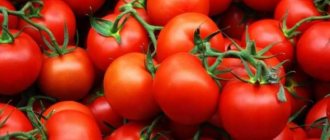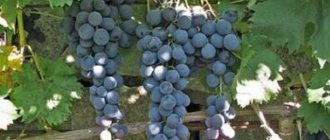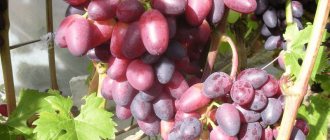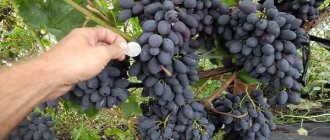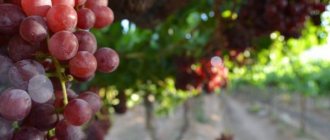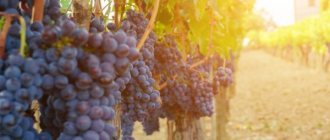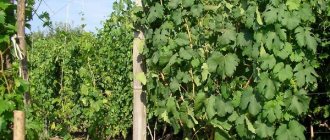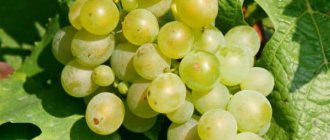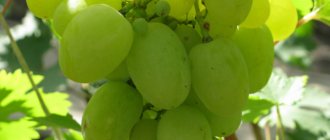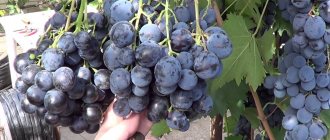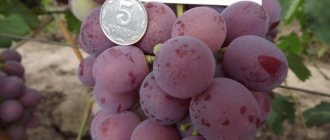Odessa Souvenir grapes are table varieties with a medium-late ripening period.
The berries can be picked at the end of September. Shakhtar, Anyuta and Shokoladny have the same ripening periods.
Thanks to its original bouquet and rich aftertaste, it is popular in red wine blends and desserts, but is also good fresh.
Withstands transportation and storage - from three months or more. Nadezhda AZOS, Bazhena and Krasa Balki also tolerate transportation well.
Bush with medium or low growth vigor. The leaf is light green, kidney-shaped, three-lobed, strongly cut.
Young shoots are light green, medium pubescent, the crown is also light green with red splashes. The flower is hermaphroditic. The bunch is medium - up to 500 g, loose, has the shape of an elongated cone, and can be pea-shaped.
Romeo, Helios and Charlie also have hermaphroditic flowers.
The berries are medium in size, weighing 5 g on average, in the shape of an elongated egg. The skin is dense, of medium thickness, dark blue with a white-lunar coating. The pulp is juicy, fleshy, with 2-3 small full-sized seeds inside.
The seeds in well-ripened berries are practically not noticeable when eaten. The taste is rich, with notes of prunes, nutmeg, and fruit. The vine is brown in color and powerful.
Description of the variety Odessa Souvenir
The variety has typical morphological characteristics inherent in southern grape varieties. Heat-loving, the fruits are sweeter than those of northern varieties. Distributed in Crimea, in the south of the Odessa and Kherson regions of Ukraine, as well as throughout the Black Sea region, where a mild and warm climate prevails.
Appearance
Powerful and vigorous bush with strong shoots. The young vine is a bright light green color, the mature one is a rich red-brown hue. Young shoots become woody quickly, within one growing season. The leaves of the plant are small, medium in size with a deep dissection, an elongated central lobe, and light hairiness on the lower part. The bush blooms profusely, the flowers are small, bisexual, collected in inflorescences. After flowering, regular conical but loose clusters develop on the bush. They produce large round berries, ovoid-oblong in shape. As the berries ripen, the color changes from dark red to dark blue, almost black.
Characteristic
The variety is distinguished by improved technological qualities. Its fruits are used for preparing grape products, as well as for fresh consumption. The harvest is stored for several months. The berries are characterized by a rich but uniform taste. They are sweet, with moderate sourness, crispy skin and juicy, fleshy flesh. Fruit sugar content is 16%, while the level of organic acids in their composition does not exceed 8 g/l. The tasting assessment of the harvest is 8.4 points. The grapes are resistant to infections. Without special treatment, the bush can withstand mildew and oidium, as well as gray rot. However, the variety is not adapted to frost (down to –15…–18°C), therefore it grows and develops safely only in the southern climate.
Productivity and fruiting
Sputnik is a medium-ripening variety; the first fruits appear on the bush on days 140–145 of the growing season, however, the sum of positive temperatures over the period should be at least 2600°C. When grown in temperate climates, fruit harvest may take until the first frost. The average plant yield per hectare is 12–13 tons. At the same time, the weight of an average bunch is in the range of 250–300 g, the berry is about 5 g.
Main advantages and disadvantages
- The main advantages of Black Souvenir relative to related varieties:
- good yield;
- resistance to many specific infections;
- excellent keeping quality of bunches;
- increased taste and aroma;
- versatility of the fruit.
- Disadvantages of the variety:
- the berries take a long time to ripen;
- the variety is affected by grape budworm;
- low frost resistance;
- bushes require constant attention and a special microclimate.
Souvenir black
(Moldavian x Hamburg Muscat). [IViV im. V.E. Tairova, Ukraine]. Synonyms: Sputnik, Odessa souvenir Black souvenir is a table grape variety. The crown of the young shoot is light green with pink and wine-red edges, covered with cobwebby pubescence. The first leaf is reddish-brick, with dense cobwebby pubescence. Subsequent leaves are light green with a bronze tint, shiny, with cobwebby pubescence. One-year-old mature shoot is reddish-brown, its nodes are more intensely colored. The leaf is medium-sized, ovate, with an elongated central lobe, deeply dissected, five-lobed. The edges are curved up. The upper notches are deep, closed, with an ovoid lumen, the lower ones are of medium depth, open, lyre-shaped, with a narrow mouth. The petiole notch is open, lyre-shaped. The teeth at the ends of the blades are large, triangular, with convex sides and a sharp apex. The marginal denticles are triangular, saw-tooth with slightly convex sides and a sharp apex. The lower surface of the leaf has bristly pubescence. The flower is bisexual. The cluster is medium-sized and large (15-20 cm long, 10-14 cm wide), conical, loose. The stalk of the bunch is long (8-10 cm), strong. The average weight of a bunch is 252 g. The berry is large (25-29 mm long, 12-15 mm wide), original oblong-ovoid shape, with an interception. Weight of 100 berries is 360 g. The color is black, the skin is covered with a medium waxy coating, thick and durable. The pulp is fleshy and juicy. The taste is harmonious, with a peculiar thorn-nutmeg aftertaste. The berry contains 3-4 large seeds.
Leading signs
Leading features: deeply dissected leaves with an elongated central lobe; conical, loose, clusters on long pedicles; black, oblong-ovate, with intercepted berries; Sloe-nutmeg flavor. The seedlings are semi-spreading. The top is light green with a bronze or orange tint. The leaves are strongly dissected, with an extended sharp central blade, without pubescence. Autumn leaf color is red and wine red.
Growing season
Growing season: from the beginning of buds to the ripeness of the berries, 142 days pass with a total of active temperatures of 2662 °C. Odessa souvenir belongs to the mid-late varieties. The berries ripen in the second half of September. The bushes are quite vigorous. Annual shoots mature by 80-85%.
Productivity.
The variety is characterized by high and stable yield. The marketability of the bunches is about 70%, the pea production is weak. Fruitful shoots are 67%, the average number of bunches on a developed shoot is 0.8, on a fruitful shoot 1.2.
Sustainability.
The variety is characterized by slightly increased resistance to gray rot of berries; it is less susceptible to mildew and grape budworm than other European varieties, and is not resistant to oidium. The frost resistance of the variety is low.
Features of agricultural technology.
In the conditions of the south, it is recommended to cultivate the Odessa souvenir on a high-standard (standard height 70 cm) cordon formation. When using a fan-shaped, standard-less forming, the best results in terms of the yield of marketable grapes per bush and per unit area were obtained with a load of 18-22 shoots, 12-14 bunches per bush, and in the case of using a standard cordon forming - 22-24 shoots and 16-18 bunches.
Technological characteristics.
According to the mechanical composition of the bunch, it belongs to table varieties (juice - 79.1%, ridges, peel, dense parts of the pulp, seeds - 20.9%). The transportability of the variety is good. The force to tear off the berries is 306, the force to crush them is 2079. Sugar content at harvest is 15.8 g/100 ml, acidity is 7.6 g/l. Tasting score of fresh grapes: 8.4 points. The Odessa Souvenir variety is used fresh and is suitable for winter storage for three or more months.
Grape sort
Odessa Souvenir grapes are an indispensable product for preparing table wines, juices and various nectars. Rich taste and large clusters are not the only advantages of the freedom-loving variety. Odessa souvenir, a grape variety that is not afraid of harsh winters, although the vine is also grown in warmer areas. The most striking features of this variety:
- delicate taste;
- a pronounced note of musk;
- juiciness;
- low level of bunch peas.
When choosing soil and a future planting site, a person can focus on any piece of land where there is enough sunlight. Otherwise, the description of the grapes indicates that no special tricks are needed to plant the variety.
Features of care
We will learn further how to care for this interesting fruit variety.
Trimming
The most necessary procedure in this case. Plants are pruned for the first time in the second year after planting. To initially give the plant the correct shape, only the central trunk and a couple of the strongest side shoots are left. After pruning, the central shoot is mounted vertically on a support, the side shoots are directed to the sides.
Without proper formation of the bush and normalization of the number of ovaries, a normal harvest will not be seen. Typically, gardeners leave no more than 6-7 eyes on each fruit-bearing shoot. This rationing produces large bunches and berries. Otherwise, there may be peas and a decrease in the quality of the crop.
Top dressing
It is imperative to feed the plant during its growing season. More minerals should be used:
The following ready-made formulations are good feeding options:
Organic matter is also welcome: for example, bird droppings, manure.
Prevention
In principle, this variety has good resistance to pests and various diseases, however, prevention in any case will not be superfluous.
The main danger in this case is not even diseases, but wasps and birds, which are not averse to eating delicious berries. You can save grapes from flying pests using protective nets and bags.
Reproduction
Like all other varieties of grapes, Souvenir is propagated vegetatively at home. Since spring planting is recommended, cuttings are prepared in the fall. They are stored in a cool place during the winter and prepared and planted in the spring.
Wintering
This grape variety is not very resistant to cold, so sheltering it is highly recommended. The procedure for preparing for winter comes down to several stages:
- First of all, they dig up the ground under the bush. The purpose of this work is to strengthen the permeable properties of the soil and protect the roots of the grapes from freezing.
- The vine is being pruned. It is necessary to remove old branches, broken, diseased, as well as those that have not had time to ripen green and bear fruit.
- The vine is removed from the trellis, tied and laid on the ground - in trenches or on plywood.
- To prevent the shoots from straightening, they must be pinned to the ground.
- The top of the plants is covered with spruce branches and straw.
- To protect the vine from dampness and precipitation, a film or other protective material is also thrown on top and secured.
- If winters are very frosty and have little snow, it is recommended to further protect the roots. To do this, the tree trunk circle is sprinkled with soil 15-20 cm thick.
Characteristics of the variety
The Odessa Souvenir grape owes its advantages to the Moldavian black hybrid.
It belongs to late-ripening varieties - the first harvest is harvested no earlier than 140-145 days. The preferred climate for the bush is warm, with moderate rains. This grape variety loves warmth and requires a lot of light. The vine has difficulty withstanding frost, especially long-term frosts - in such cases, special shelters are installed to protect the crop. This type of grape is resistant to most diseases that affect garden crops.
Description of the bush
According to the description, the bush is medium tall. The color of annual shoots is dark brown or burgundy. The leaves have an elongated, ovoid shape: they densely and evenly cover the vine. The first leaf is brick red in color. The pubescence is cobwebby and moderately dense. Younger leaves have a bronze tint. The leaf blade is smooth, light green, rich in color.
Leaf characteristics:
- the leaf has five separated parts and a noticeable dissection;
- the edges of the foliage are curved upward;
- the lower cutout has a closed mouth, and the upper cutout has an orifice of medium depth;
- There are teeth along the edges of the foliage.
Feng Shui color of the front door
Description of the bush: the crop is formed in the form of conical clusters on two-year-old branches. The shoot of the bush ripens well. The vine quickly grows on the sides and needs additional support.
Description of fruits
The Odessa Souvenir grape variety is characterized by delicious fruits. They are juicy and moderately meaty. General description of the fruit:
- the weight of one berry is up to 5-6 g;
- the shape of the berry is round, slightly elongated downward;
- the bunch is extended downwards, its average weight is up to 300 g;
- the pulp is dense;
- the seeds are small and hard;
- the berries are covered with a thick peel that does not crack even with excess moisture;
- The taste of the fruit is sweet, but unobtrusive.
- musky berry aroma;
- per 100 ml of berries the sugar content is 15-16 g.
Odessa Souvenir is an early ripening grape variety used for making juices - they turn out thick with a rich taste. The dense pulp contains useful substances.
Characteristics
Odessa souvenir is “friendly” with most rootstocks. The shoots ripen by 80-85%. The cuttings also take root well. Fertility is high - more than 110 centners per hectare. Sugar content is approximately 15g/100 cubic meters. cm.
Acidity - 8g/cubic dm. Afraid of rain, spring frosts, needs shelter for the winter. It resists frosts weakly - the maximum “minus” of the Odessa souvenir is 20 Celsius. When rationing, it is recommended to leave six to seven eyes on the shoot. Resistant to gray rot and leaf rollers, but can be affected by powdery mildew.
Cultivation
Selecting a location
The plant needs sunlight.
The grape bush is planted in an open, illuminated area. It is better to choose the south side, where there is no shadow or drafts. The bushes grow quickly, so a spacious plot of land is prepared for the rhizome.
Planting in open ground
According to the description of the Souvenir grape variety, the depth of the dug hole should be at least 80 cm, which will allow the vine to quickly grow and develop. A young treated seedling is immersed, soaked in water for 5-6 hours, up to the level of the root collar. Before planting, the cuttings are inspected for signs of damage or rot.
After planting, the seedling is watered abundantly - at least 10 liters of water are poured in. A support is installed for the young vine, which will ensure proper growth of the grapes. The bushes are planted at a distance of 1 m from each other. Additionally, the vines are pruned, which prevents young shoots from rotting. The variety quickly takes root during the first weeks and does not require additional soil fertilization.
Description
Let's get acquainted with the main distinctive features of the variety.
Selection
The Souvenir grape is a hybrid variety obtained in Soviet times by breeders from Ukraine and Russia. Moldovan winegrowers also took part in the development.
The basis was taken from black Moldovan hybrid grapes and muscat originally from Hamburg. From one “parent” Souvenir took resistance to climatic conditions, from another – large fruit, high yield, excellent taste.
Characteristics of the vine
- Souvenir grapes are medium-height bushes with shoots colored in a characteristic light brown shade.
- The leaves are small, oval in shape, and the lobes are not clearly separated.
- The color of the leaves is slightly reddish at the top.
Description of the bunch and fruits
- Souvenir grapes form a medium-sized bunch.
- The mass of the bunch is 500-800 grams, sometimes reaching the kilogram mark.
- The structure of the bunch is loose, the berries are not densely located in it.
- The shape of the brush is cone-shaped, standard.
- The berries differ from other grape varieties in that they have a very original narrowed shape.
- The weight of one berry is 5-8 grams.
- The color of the fruit is dark - blue or purple, inky.
- The berries have a dense skin, but this density is not felt by taste.
- The surface of the fruit has a smoky coating.
Taste characteristics
The fruits of the souvenir grapes have autumn juicy and aromatic pulp with notes of:
Even the presence of seeds in the pulp cannot spoil the impression of the excellent taste of the berries.
Ripening time and yield
The Souvenir variety ripens in the mid-late period: the fruits are harvested in the second half to the end of September. Note that the clusters can hang on the branches for a long time after full ripening, gradually acquiring an increasingly rich nutmeg taste.
As for the yield, in this case it is consistently high. From one hectare of vineyard you can harvest 120 centners of delicious fruits.
Stability characteristics
The Souvenir grape has high stable characteristics: in particular, diseases and pests characteristic of the crop almost never affect this variety. Many gardeners will be pleased with the fact that the Souvenir variety is not susceptible to mildew.
Resistance to frost is lower. If the vine can withstand cold temperatures down to -18 degrees without shelter, then in case of lower temperatures it is necessary to cover it.
Features of planting a Black souvenir
Proper planting is the main condition for abundant and long-lasting growth and fruiting. Grapes are grown only on the well-lit southern side of the site, away from tall vegetation and other shading objects. It is better to plant cuttings on a small hill, then the plants develop better and bear fruit faster. Before planting, you need to prepare the area. You can plant cuttings in any well-fertilized soil, but the bushes develop better on substrates with low moisture capacity. Stagnation of moisture not only inhibits the growth of grapes, but also leads to putrefactive lesions of the roots.
For planting, dig a deep hole in the soil (80x80x80 cm). A drainage layer of gravel, pebbles or broken bricks 5–10 cm thick is placed at the bottom of the hole. Next, it is filled with a mixture of soil and manure or humus (1:1). After this, clean soil is placed on top of the hole in a small mound. Planting of seedlings begins in a week. During this time, the soil restores its structure, and fertilizers saturate it with nutrients. In the prepared area, small depressions are made (according to the size of the root system), a cutting is placed there, which is then loosely sprinkled with soil. At the same time, there must be a distance of at least 1 meter between each plant, otherwise they will compete for nutrients and living space.
After this, the beds are well watered with water (at least 10 liters/1 plant) and, if necessary, each cutting is tied up. There are two methods of planting grapes: before winter (early October) and spring (in March). Both are common in gardening, but spring rooting of grapes is considered the most effective. At this time, there is a natural activation of the plant’s metabolism, as well as the growth of its cells. As a result, it quickly adapts to new conditions and produces lateral shoots by the end of the season. In addition, due to low frost resistance, autumn planting can cause freezing and death of planting material.
Post-planting care
As mentioned above, the variety requires special living and maintenance conditions, so in order to achieve high yields, you will need to pay attention to the plantings daily. In addition to watering and fertilizing, the plant must be pruned, since an excessive number of shoots depresses the overall yield and leads to a reduction in bunches and berries.
Trimming
Sputnik is pruned regularly; young seedlings are shortened as shoots grow in autumn or spring. The procedure is carried out in such a way that no more than 3-4 main shoots with several viable buds are left on the bush. Adult bushes are pruned 2 times per season, before and at the end of the active growing season. During spring pruning, excess shoots are removed from the bush, and the shoots are shortened so that branches with 6–7 active buds develop on one plant. In the fall, sanitary pruning is carried out - old, damaged, diseased and non-viable shoots are removed.
Watering
Grapes are moisture-loving crops, but do not tolerate stagnation of moisture in the soil, otherwise this will lead to rotting of the root system. Young seedlings are watered once a week; around mid-summer, the frequency of watering is reduced to 1 procedure every 2–3 weeks. Adult bushes are watered once every 2-3 weeks. During the rainy season, watering is stopped to avoid moisture stagnation. By mid-September, watering is stopped - from this time the plant can be prepared for wintering. For irrigation, only clean, settled water is used; depending on the age, from 5 to 15 liters of water are poured under one bush.
Find out in more detail how to properly and how often water grapes in the summer.
Mulching
Mulching is not a mandatory procedure, but it simplifies the care of grapes. Using mulch, you can achieve a special soil microclimate, as well as protect the soil from drying out and freezing. Thanks to this, the grapes not only grow more actively, but also produce high-quality harvests. In addition, mulching reduces the number of weeds in the grape bed.
The procedure is carried out at any time during the growing season, but it is better to protect the plantings in the fall or immediately after planting. Sawdust, fallen leaves, bark, and hay are often used as mulch. The thickness of the layer on the soil should be at least 10–15 cm. In recent years, agrofibre has been used. This is a synthetic material characterized by gas permeability and thermal insulation properties.
Loosening the soil
Timely loosening is important for grape fruiting. With the help of the procedure, the soil is freed from weeds, becomes light and gas-permeable. This saturates the soil and root system of the plant with oxygen, which is important for the development of the bush. In the spring, loosen the soil at least 2 times, after the snow melts and before flowering. The soil is dug up to a depth of 20 cm, after which it is crushed with a rake. In summer, the vineyard is loosened as necessary, after the appearance of weeds and heavy rains. In this case, the procedure eliminates the oversaturation of the beds with moisture. The soil is loosened for the last time after harvesting, before preparing the bush for wintering, removing insect pests from the soil.
Important! Loosening is carried out carefully, without damaging the root system. Otherwise, the grapes will produce small berries, and their yield will decrease.
Historical past of the variety
A prominent representative of table varieties, Odessa black grapes belong to the mid-late variety, which is ready for harvest in early or mid-September. The summer sun and warm climate help large clusters ripen faster, and by the beginning of autumn, land owners can already enjoy sticky, sweet berries. Grapes of this variety are used in the production of wine (table variety), which is obtained with a special aftertaste and a rich bouquet. A fragrant, heady dessert wine will come in handy at any magnificent celebration.
ModaGid.ru || Makeup for green eyes: photos and videos
The Souvenir grape variety is famous for the unique taste of ripe berries, which are consumed raw in late summer or early autumn. Transporting grapes is easy; when raw, they remain fresh for up to three weeks, which is a definite plus for bunches for sale. What conditions are necessary for the vine and how to properly graft such a variety?
Features of the Souvenir grape variety
The Souvenir grape cannot be confused with any other variety. A real southern find for a skilled gardener, and a decoration for any garden or gazebo. Noble, easy to care for, durable and incredibly tasty Souvenir variety will not leave anyone indifferent.
Grapes growing under the Odessa sun will fit into any vineyard, and ripe berries will forever be remembered by lovers of rich grape taste. The description of the variety and its detailed characteristics will allow you to make an informed final decision about whether it is worth growing Souvenir, originally from Odessa?
Grape sort
Odessa Souvenir grapes are an indispensable product for preparing table wines, juices and various nectars. Rich taste and large clusters are not the only advantages of the freedom-loving variety. Odessa souvenir, a grape variety that is not afraid of harsh winters, although the vine is also grown in warmer areas. The most striking features of this variety:
- delicate taste;
- a pronounced note of musk;
- juiciness;
- low level of bunch peas.
When choosing soil and a future planting site, a person can focus on any piece of land where there is enough sunlight. Otherwise, the description of the grapes indicates that no special tricks are needed to plant the variety.
Historical past of the variety
A prominent representative of table varieties, Odessa black grapes belong to the mid-late variety, which is ready for harvest in early or mid-September. The summer sun and warm climate help large clusters ripen faster, and by the beginning of autumn, land owners can already enjoy sticky, sweet berries. Grapes of this variety are used in the production of wine (table variety), which is obtained with a special aftertaste and a rich bouquet. A fragrant, heady dessert wine will come in handy at any magnificent celebration.
The Souvenir grape variety is famous for the unique taste of ripe berries, which are consumed raw in late summer or early autumn. Transporting grapes is easy; when raw, they remain fresh for up to three weeks, which is a definite plus for bunches for sale. What conditions are necessary for the vine and how to properly graft such a variety?
Description of bunches of grapes Souvenir
Souvenir is a grape of average ripening speed, but easy to care for. The description of not only the variety, but also the special needs allows us to see the prospect of planting a bush of Odessa grapes. What is black Odessa? Basic description of this variety:
- The growth vigor of the bush is considered low or average, so the owner of the site will not have to worry about landscaping the long vine. Not the tallest bush can still serve as a good shade in the summer heat. The density of the perennial bush is also average, and when decorating gazebos or other secluded corners, this variety will come in handy.
- The leaves of the grapes are light in color (closer to green). The shape of the leaves is unusual, as if divided into three identical layers. With good watering, the bushes grow on the sides, and its leaves create a large green hedge that does not let in sunlight.
- The pubescence of the pagons is average. The shoot is light green, but on the crown of the bush you can see small red specks.
- The variety blooms quickly in summer; the inflorescences themselves are hermaphrodites.
- The clusters are small in size - up to half a kilogram each. The Vaskovsky variety stands out among similar types of grapes due to the elongated shape of its berries. Black Russian grapes are difficult to confuse with table varieties, because the size of the bunches of Odessa grapes is much larger.
- A large berry gains weight up to 5 grams, which is quite a lot for such a bunch. The Souvenir variety is used in preparing delicious baked goods due to its thick skin, which retains the full taste of the berry for a long period. The picked bunches remain ripe and suitable for consumption for up to a month. The color of the clusters is dark blue, from a distance similar to black with a bloom, reminiscent of a new moon. An unripe bunch has a pink color, and the berries themselves taste sour. There is no need to rush into harvesting grapes; even with heavy watering, the berries do not crack, and the bunches remain whole and juicy.
- As for the seeds, it is quite difficult to find them in the berry, and therefore, immediately after harvesting, the grape bunches can be safely eaten raw.
The Souvenir variety tastes like ripe prunes, with small additions of fruit and nutmeg. The taste qualities of Odessa grapes are simply irreplaceable in the process of preparing high-quality table wine. This natural drink is suitable for meat dishes and desserts. The costs of sugar and other components are minimal, so Odessa is also very economical.
Reliable appearance, ease of care and large yield - it is difficult to find equals to this grape variety.
All that is needed for its active growth is sunlight, and the more, the better. Despite the many advantages, each variety of table grapes has disadvantages. What are the arguments against planting black Odessa?
Selection and main characteristics of the variety
Heat-loving noble Odessa varieties appeared as a result of crossing Black Moldavian and Hamburg grapes. Low, spreading bushes are common near the sea, where there is a lot of sun and little coolness. These table species love a mild climate with little rainfall. The favorite of Odessa has a hard time withstanding frosts and periods of heavy rain. If bad weather fails to interfere, bushes and pagons are covered with a tarpaulin. High humidity can harm not so much the berries as the root system of the grapes.
Table varieties of this type can be planted on any soil, even clay.
The shoots and vines will still take root. Dangerous for berries is the invasion of birds and various insects. To prevent damage to the crop, the bushes are covered with nets and carefully fenced. Special bags that are placed on the ripening bunches will help keep the bees away. The owner of the site should take care that there are no wasp nests nearby that will become a cause for concern. Special traps and baits help against other types of insects. All the effort spent on protecting the harvest will be repaid by its quality and incredible taste of each berry.
Sources: https://selo.guru/sadovodstvo/vinograd/odesskij-suvenir.html https://vinograd.info/sorta/stolovye/syvenir-chernyi.html https://vvinograd.ru/sorta-vinograda/sort- vinograda-odesskij-suvenir.html https://remontanta.ru/sorta-vinograda/234-vinograd-odesskij-suvenir https://fermoved.ru/vinograd/suvenir-sorta.html https://lozaved.ru/sorta /suvenir.html https://provinograd.com/sorta/opisanie-i-vyrashhivanie-vinograda-sorta-yulian.html
Plant care
The Odessa Souvenir grape harvest takes place in early September. All summer the vine needs watering, fertilizing the soil and trimming excess vines. Immediately after planting, Odessa Souvenir is fertilized with mineral fertilizers.
Mandatory care includes:
- loosening the top layers of soil;
- weed removal;
- regular watering;
- disease prevention.
A prerequisite for proper growth of the vine is pruning the vines. Such work is carried out in the spring before fruit formation. Irregular pruning is carried out in cases where the bush is sick - damaged shoots are cut off, and the cut site is treated with a disinfectant solution. During the winter, watering the crop is stopped and resumed in early spring, when the upper layers of the soil warm up. In order for the Odessa Souvenir variety to grow faster, organic fertilizer is applied every 2 years. In summer, watering is carried out as the soil dries out.
Grapes “Souvenir” - description of the variety, photos, reviews and opinions of winegrowers
- Victor: I have had this variety for a long time... It ripens right away (late autumn) but I keep it for its wonderful taste... Muscat is available in many varieties, this one is valuable for its thorn-plum + nutmeg taste... One year I tried to make wine from it ...that is, I put it into sepage... Even the young wine had a strong bouquet (similar to the bouquet of saperavi) tannic astringency in the taste...... It’s a pity that it picks up little sugar
- Andrey: Quite resistant to mildew, and very unstable to oidium. Doesn't tolerate overload at all. The variety is late in my conditions - the first ten days of October. Covering. It lays two or three inflorescences per shoot, so it requires rationing: to obtain marketable bunches, leave one bunch per fruitful shoot.
On its own roots - sredneroslik. I keep one bush for its original berry shape and taste.
- Sergey: My bush has been growing for about 10 years; my wife likes it for its nutmeg-thorn taste, but I won’t expand its planting. Firstly, low yield and winter hardiness. Secondly, large seeds and a dense peel, which does not protect against wasps (wasps love it). Thirdly, the stepsons on which mildya settles are very driven. But I don’t think about throwing it away.
- Dmitry Alekseevich: In Donetsk, the variety ripened in early September. For better ripening of the berries, you need to remove the leaves near the cluster; weakly colored berries are sour. Market grade. I refused the variety due to its low yield, the brushes are calibrated, but small.
- Nikolay: And I have complaints mainly about the seeds (their number) in the berry, on a 4-year-old bush this year there were 32 bunches (450-650g), the bush grew very well (the vine ripened perfectly), the acid lasts a long time.
- Oleg: In Lvov it probably won’t be able to, but in Crimea and Moldova it’s easy: from the first days of September until the end of the month, our wholesale OS is full of OS. They bring it from Crimea and Moldova.
Each winegrower has his own “key” to the described variety. For some, these are “Spartan” growing conditions, for others, careful care and feeding with complex fertilizers. The form was zoned in the Odessa and Kherson regions, and performed well in the Poltava region. But vine growers in the Krasnodar region sometimes complain about low sugar accumulation or uneven ripening.
forum.vinograd.info
Reviews from gardeners
Alexander: “There are no complaints about the taste and quality of the fruit, but I have never seen a better berry for compotes! But the variety absolutely does not tolerate overload. This leads to the development of small berries and clusters.”
Victor: “I’ve had this variety on my plot for a long time, it always ripens back to back. The clusters are beautiful, the berries are aromatic, tasty, with a nutmeg aftertaste. But, grapes are greatly influenced by free space. My yield is lower than my neighbor’s, on a larger plot.”
Anna: “The fruits of the Odessa souvenir have an attractive appearance, their shape is elongated, their color is deep blue, and their taste is harmonious. The only drawback for me is the huge number of dense seeds in the berry, which make it difficult to enjoy the grapes.”
Andrey: “The variety is good, it is resistant to diseases and pests, the fruits are aromatic, with a light nutmeg aftertaste. The bush does not tolerate overload at all and requires timely rationing, so I leave only 1 bunch per shoot. Sputnik is demanding in terms of care, so it is not suitable for a beginner.”
Odessa Souvenir is a universal southern variety, characterized by high yields and improved production characteristics. Its fruits are suitable for fresh consumption and food processing. The variety is demanding in terms of maintenance conditions, so it will take a lot of effort to provide them. The grapes are heat-loving, so they will grow only in mild climates with warm and short winters.
Appearance and other characteristics
- Purpose of the variety: table;
- Variety acidity: 7.6 g/l;
- Sugar content of the variety: 15.8 g/100 ml;
- Bunch shape: conical;
- Bunch weight: 270 g;
- Berry shape: oblong-ovoid;
- Berry color: black;
- Berry size: 5 g;
- Taste: harmonious, rich, sweet;
- Ripening time: 140-145 days;
- Frost resistance: weak;
It is necessary to take into account that this hybrid variety allows you to significantly diversify the menu and get a large charge of vitamins and microelements necessary for humans. Widely popular today among professional winegrowers and amateur gardeners, the Souvenir grape can be characterized by the following indicators:
- Bushes of medium height, mature shoots - annuals are painted in a characteristic bright brown-red color. The leaf is not large in size, oval in shape. The variety is characterized by the reddish color of the upper leaf. The next ones on the shoot have only a shade of bronze on a light green background.
- Young annual shoots are light green in color and not very intensely pubescent. The grapes bloom with bisexual inflorescences and are hermaphrodite species that are actively pollinated.
- A bunch of medium size from 500.0 g to 950.0 - 1000.0 has a loose texture, in the shape of an elongated cone, and has a tendency to peas. The weight of the brush depends on the characteristics of the cultivation region and the climate during the season.
- Particular attention is drawn to the berries of a very non-standard shape, weighing from 5 to 8 g. They are more reminiscent of an ellipse or an egg, they are distinguished by a peculiar interception and a juicy black-blue hue. The Souvenir variety is also characterized by dense but delicate skin of the berries, which is covered with a natural waxy coating.
- The berries are distinguished by their juicy, aromatic pulp, shaded with notes of sloe, prunes, flowers and a nutmeg flavor. The presence of a few seeds cannot spoil the overall tasting experience.
- The variety is mid-late, harvesting occurs in the second half of September, but even after full ripening, the clusters can remain on the bushes from 30 to 60, and sometimes up to 90 days, until frost.
- Keeping the berries at low temperatures gives them a special subtle aroma and sugary pulp, and the skin becomes crispy with a characteristic sound when biting.
vinogradmoy.ru
Diseases and pests
As it becomes clear, this souvenir must be carefully protected. Fortunately, there are not so few hunters for him.
Of course, these are the first enemies of grapes - wasps and birds. But they can be easily stopped with nets - rigid and reinforced against birds, bags for packing bunches - against striped aggressors.
All wasp nests found on the site must be destroyed. Dichlorvos and poisonous sticky baits are also effective against insects. You just need to make sure that they are not too “fragrant” - a strong amber will quickly tell the wasps that they are being fooled.
The situation is somewhat more complicated with those who are not so easy to distinguish with the naked eye . These include oidium .
First of all, diseased bunches and branches must be separated from healthy ones if you don’t want your jam or wine to noticeably smell of mold. The virus adheres tightly to grape leaves and overwinters well behind the bud scales. Therefore, spraying with chemicals should begin immediately after signs appear.
against real mildew : sulfur-containing preparations, as well as the fungicides Rubigan, Karatan, Bayleton. Spraying with sulfur will not give any effect at low temperatures, and at too high temperatures it will burn the bush. Therefore, sulfur is sprayed in the morning and evening hours.
Another formidable scourge is bacterial cancer . The most effective method against it, as well as against oncology in general, is prevention . You need to ventilate the bush well and handle it carefully, trying to avoid even minor wounds or scratches. Unfortunately, a diseased bush will have to be uprooted.
Don’t forget about such common grape diseases as anthracnose, chlorosis, bacteriosis and rubella.
An Odessa souvenir is truly a jewel. Rarely do you find grapes with such a sweet and rich , revealing taste. It is not enough to be a resident of the south to afford to acquire this variety; you also need to carefully care for it, protect the grapes from wasps, birds and fungi, such as powdery mildew and bacterial cancer.
Watch this helpful video:
Care and reproduction
Pruning is optimal for 6-7 eyes. It is not necessary to standardize by inflorescences. The variety pulls out all tied brushes, since they are small in size. But stepson formation is high, especially on fertile chernozems. Excess shoots have to be broken out so as not to thicken the bush.
When cultivating the Odessa souvenir with a fan in a standardless mold, it is recommended to leave 18-24 shoots and 12-16 brushes per bush. If you form it into a standard and grow it on a cordon, you can leave 22-24 shoots and 16-18 brushes, respectively.
Cuttings take root well, so growing your own rooted bush seems easy. However, grafted seedlings are more often sold using, for example, phylloxera-resistant Kober 5BB as a rootstock. The Odessa souvenir begins to bear fruit in 2-3 years.
remontanta.ru
Rules
- The hybrid is a heat-loving variety; it requires a fairly large amount of sunlight. Souvenir is exclusively adapted for cultivation in the original wine-growing regions - in the south of Russia and Ukraine.
- With care that complies with the rules of agronomy, a maximum of 75–80% of shoots capable of bearing fruit are left on the bush.
- The optimal solution would be 5–7 buds on each shoot; when forming a bush, a fanless standard technique is used; the standard should not exceed 60–70 cm in length.
- The berries retain their marketable condition well and do not lose their appearance or taste during transportation. The yield is high - up to 110 c. per hectare.
- Serious problems for the safety of the crop are caused by wasps and birds that feed on the sweet, ripe fruits of the vine. A positive factor for its cultivation is its resistance to traditional grape pathologies.
vinogradmoy.ru
Features of culture Souvenir
The grape variety, which today is known as the famous Souvenir, was bred at breeding stations in Ukraine, where employees of the S. Tairov Research Institute of Vitality and Vineyards worked. Thanks to the basic Ukrainian and Moldavian crops taken as the basis for the reproduction of new grape varieties, here, in a fertile climate, various varieties of grapes with specified sugar, acid and other properties interesting for production were cultivated. Many varietal grapevines were produced here, but the culture that was given the name “Souvenir” is distinguished by numerous differences from other, no less interesting grape varieties. First of all, the varietal grapes that were new a couple of decades ago are distinguished by the following features.
The Souvenir grape variety was bred at breeding stations in Ukraine
- The greatest number of positive properties were obtained through crossing the black Moldavian hybrid and the Hamburg Muscat variety in the breeding process.
- The ripening period is quite long, up to 145 days, which makes this variety one of the most popular late-ripening species, ripening both for commercial purposes on large plantations and in the gardens of amateur winegrowers.
- It is precisely due to the length of development that Souvenir is most suitable for regions where the climate is mild, warm and rather humid. Zoning is determined by the southern regions of Russia. The plant is designed for plenty of sunlight, heat and slight frosts in winter.
- However, the medium-growing Souvenir type vine is not adapted to tolerate high humidity during the rainy summer seasons.
- The variety, due to the fact that it is a secondary hybrid, has become excellent at resisting the most dangerous type of table grapes.
Reviews of grapes “souvenir”
There are a lot of them. Judging by the most reliable reviews about the “souvenir” grape variety, a number of advantages can be identified:
- high yield - more than one hundred and twenty centners per hectare;
- stable acidity and sugar content;
- the highest taste and aroma qualities;
- high-quality mechanical composition (percentage ratio of juice and unused parts of the berry);
- long-term storage (about three months) and transportation;
- resistance to many diseases (for example, gray mold and grape leaf roller).
Undoubtedly, this variety also has its drawbacks, namely the long period of full ripening (at least one hundred and forty-two days) and complete intolerance to low temperatures (below minus twenty degrees Celsius).
Grapes Souvenir - characteristics of the variety and care for it
In the last century, Soviet genetics was the subject of lively debate for several decades. Either selection based on genetic innovations was recognized as almost witchcraft, or the real achievements and possible prospects of its applied experiments were considered as a real breakthrough in the field of the formation of fundamentally new plant varieties. It was in the second half of the twentieth century that research institutes and stations involved in grape breeding were organized in a variety of agricultural areas. The most famous were the Research Institutes of Moldova, VNIIViV named after. Ya. I. Potapenko in Novocherkassk and NIIViV named after. Tairov in Ukraine. The developed varietal directions for the development of cultivated grapes are still of particular value today for viticulture, winemaking and, in general, for the development of agriculture in general. The today famous Souvenir was also produced here, about which you should learn more.
Yield characteristics
The undoubted advantage of this variety is its high yield, the ability to easily tolerate transportation and fairly long-term storage. And, of course, the most important indicator for grapes is the assessment of taste. The “souvenir” variety has a fairly high score - 8.64 points on a ten-point scale. Sugar content is within fifteen grams per milliliter, acidity is from seven and a half to eight percent. The berries provide more than seventy percent of the juice of the total mass. Such characteristics are most important for winemakers and grape juice producers.
Landing
Let's find out what features of rooting exist in this case.
Selecting a location
It is necessary to plant the plant in the sunniest part of the garden: Souvenir grapes will not be able to grow and bear fruit normally without sufficient lighting and heat. Shady places and even partial shade are absolutely not suitable.
Recommendations for planting
- In this case, it is necessary to dig a larger hole than for other grape varieties. The fact is that the root system of Souvenir is quite powerful and branched. Optimal parameters: 80x80x80 cm.
- Place drainage and a layer of fertile soil mixed with humus at the bottom of the recess. In such a nutrient medium, the grapes will quickly take root.
- After planting, be sure to water the plant, using at least 1-1.5 buckets of water per bush.
- Take care of the support - it should be located next to the bush.
- If you plant several specimens, keep a distance of at least a meter between them. This grape variety grows quite strongly over time.
- It is recommended to plant the plant in spring. But you need to prepare the soil and pit in advance - at least a couple of weeks in advance. Ideally, the work should be completed the previous fall.
How to build a support
For Souvenir grapes, the presence of a suitable support nearby is mandatory: without support, the vine will not be able to climb up. It is necessary to construct the supporting structure simultaneously with the preparation of the planting pit.
A suitable building material for a trellis is metal pipes with a diameter of 2-2.5 cm. You will also need strong wire for the work. The pipes will be vertical elements, the wire should be pulled horizontally.
The bottom row of wire is located at a level of 40 cm from the ground, not lower. If pulled too low, the grape leaves may begin to rot on the ground. The distance from one horizontal level to another is 35-40 cm. Fix both vertical and horizontal elements well.
Reviews
Souvenir grapes are very popular among gardeners. Let's find out how its owners respond to this fruit crop.
There are grapes growing on my plot: the whole family loves these berries, and there are some left over for sale. Several years ago we planted the Souvenir variety, and now it is our favorite. At first we were surprised by its berries - pointed at the end. But how delicious they are!
I would also like to note that this grape hasn’t given me any illnesses in six years and it tolerates winter well. I don't cover it, but I think in colder climates it will be necessary to cover it. The downside is that wasps love sweet berries. This is just a disaster, we can only save ourselves with nets.
I am fond of gardening and grow grapes, too. I have several varieties growing, and I also have Souvenir. This variety is popular for its delicious berries, their original shape, and resistance to disease. Among the disadvantages is the need for rationing, and wasps are very fond of grapes. Overall, the impressions are good, I plan to plant a few more Souvenir bushes.
Planting grapes "souvenir"
For planting, you need to choose the sunniest place. It is best to prefer hilly areas on the south side. Thanks to its location on a hill, the bush will always be supplied with fresh air. Since the bush has a powerful root system, dig a hole for the seedling with a depth and diameter of at least eighty centimeters. It is advisable to pour a layer of maximally fertile soil and compost at the bottom. Only after this should the seedling be covered with ordinary soil. The next step when planting is abundant watering - at least fifteen liters of water for each seedling.

